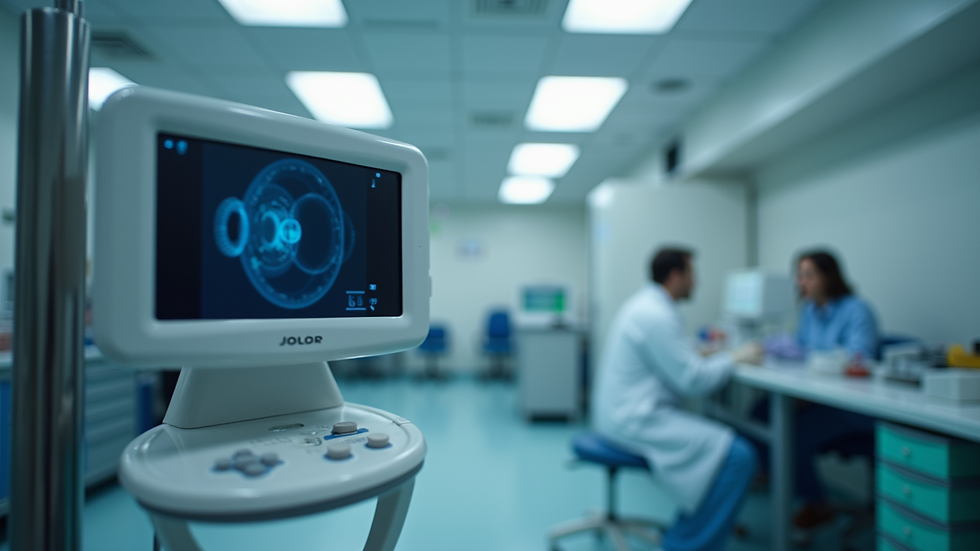The Role of Precision in Modern Medical Components
- Dale Glenn- President/Owner
- Jul 21
- 4 min read
Updated: Jul 28
In the ever-evolving field of healthcare, the accuracy and reliability of medical devices are paramount. High-precision medical components are integral to ensuring these devices function correctly and safely. As technology advances, the demand for these components has increased significantly, making it essential to understand their role in modern medicine.
Understanding High-Precision Medical Components
High-precision medical components refer to the meticulously designed and manufactured parts that make up medical devices. These may include screws, tubes, casings, and sensors, all of which must meet strict regulatory standards. The importance of precision in these components cannot be overstated. For instance, even a minute error in manufacturing can lead to catastrophic failures.

The criticality of accuracy in these components highlights the importance of advanced manufacturing techniques. Techniques such as CNC machining and 3D printing allow for high levels of precision and customization, making it possible to produce components that meet specific requirements and specifications.
Importance of High-Precision Medical Components
High-precision medical components play a vital role in several areas of healthcare. A few key points to consider include:
Safety and Efficacy: The primary goal of any medical device is to provide safe and effective treatment. High-precision components enhance the device's reliability, reducing the risk of malfunctions that could endanger patients.
Regulatory Compliance: Medical devices are subject to stringent regulations. Utilizing high-precision medical components helps manufacturers comply with these regulations by ensuring that their devices meet the required standards for quality and performance.
Technological Advancements: As technology progresses, the complexity of medical devices continues to grow. Incorporating high-precision components allows for the integration of sophisticated features, such as electronic monitoring and advanced diagnostic tools.
Cost Efficiency: Investing in high-precision components can lead to cost savings in the long run. While the initial manufacturing costs may be higher, the reduced risk of device failure can save significant amounts in recalls, legal issues, and lost patient trust.

What are the Components of a Medical Device?
Medical devices are often made up of several key components, each serving a unique function. Understanding these parts can give insights into the significance of precision. Here are a few critical components:
Sensors: These are crucial in monitoring patient conditions. Sensors need to be highly precise to accurately capture and transmit data.
Actuators: Actuators control movement in devices. High precision is required to ensure they function seamlessly and respond correctly to inputs.
Microcontrollers: These chips process the data collected by sensors. High precision in these components allows for faster and more accurate data analysis.
Batteries: The longevity and efficiency of a medical device can be largely determined by its power source. High-precision components ensure these batteries operate at optimal levels.
Casing and Housing: The enclosure that protects the internal components needs to be durable yet precisely crafted to allow for proper ventilation and longevity.
Industries That Rely on High-Precision Components
Several industries within the medical field require high-precision components. These include:
Surgical Instruments: Precision in surgical instruments is critical for ensuring success in various procedures. Instruments must be accurately manufactured to enable surgeons to perform intricate tasks.
Diagnostic Equipment: Devices like MRI machines and blood analyzers depend on high precision for accurate readings. An errors in the components can lead to misdiagnosis or improper treatment plans.
Prosthetics: Custom prosthetic devices require meticulously crafted components to ensure a perfect fit for the individual user. Precision manufacturing is essential to enhance performance and comfort.
Wearable Health Tech: With the rise of wearable technology such as fitness trackers and smartwatches, precision components are necessary for accurate monitoring of health metrics.

The Future of High-Precision Medical Components
As technology develops, the future of high-precision medical components appears promising. The integration of artificial intelligence and machine learning into manufacturing processes is expected to yield even higher levels of precision. Furthermore, the growth of personalized medicine will drive the demand for components that are not only precise but also tailored to individual patient needs.
The rise of 3D printing technology has also revolutionized the production of medical components, making it easier to produce custom parts quickly and accurately. Manufacturers can create parts that fit specific anatomical requirements, allowing for better patient outcomes.
As healthcare continues to evolve, the importance of precision medical components will remain a focal point. The commitment to quality and accuracy ultimately leads to improved patient care and innovative advancements in the medical field.
Emphasizing Quality and Reliability
In conclusion, the role of high-precision medical components is paramount in the modern healthcare landscape. From ensuring regulatory compliance to enhancing the efficacy of medical devices, these components are the foundation upon which the safety and success of medical treatments are built. Investing in quality and precision can lead to significant advancements in patient care and outcomes.
Manufacturers and healthcare providers alike must prioritize high-precision components to keep pace with the evolving standards of modern medicine. Ensuring that devices are built with the highest levels of precision guarantees not only the safety of patients but also the trust and integrity of the medical profession.
For more about the manufacturing and components involved in creating precision medical components, visit Glenn Enterprises for detailed insights and capabilities tailored to the medical device industry.






Comments